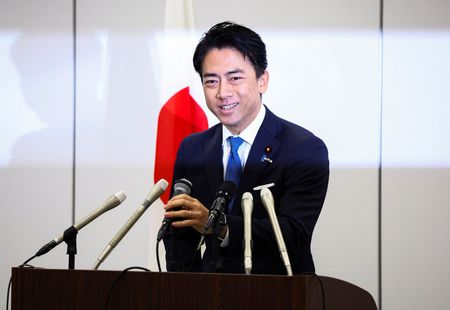By Tim Kelly and Joseph Campbell
TOKYO (Reuters) -Japan's ruling party began voting on Saturday to choose the country's likely next prime minister, hoping to regain trust from a public angered by rising prices and drawn to opposition groups promising big stimulus and clampdowns on foreigners.
Farm minister Shinjiro Koizumi, 44, who would be Japan's youngest premier in the modern era, and conservative nationalist Sanae Takaichi, who would be its first female leader, are the frontrunners to lead the Liberal Democratic Party, according to opinion polls.
Also considered a contender is Chief Cabinet Secretary Yoshimasa Hayashi, 64, a centrist party veteran who has held the weighty foreign, defence and agriculture portfolios.
LDP 'ROTTING FROM WITHIN'
Voting among lawmakers and rank-and-file party members nationwide began at 1 p.m. (0400 GMT), with the ballot expected to go to a runoff and conclude around 0630 GMT.
A vote in parliament to choose a prime minister to replace Shigeru Ishiba is expected to be held on Oct. 15.
The new LDP president is likely to succeed Ishiba as leader of the world's fourth-biggest economy because the party, which has governed Japan for almost all the postwar period, is the biggest in parliament. But this is not assured as the party and its coalition partner lost their majorities in both houses under Ishiba in the past year.
Various other parties, including the fiscally expansionist Democratic Party for the People and the anti-immigration Sanseito have been steadily luring, especially younger voters, away from the LDP.
Whoever succeeds Ishiba will inherit a party in crisis.
"The LDP is rotting from within, so it's about time for a reset," said Takaichi supporter Osamu Yoshida, 70, speaking outside Shimbashi commuter train station in Tokyo.
Takaichi offers the starkest vision for change, and potentially the most disruptive.
An advocate of late premier Shinzo Abe's "Abenomics" strategy to jolt the economy with aggressive spending and easy monetary policy, she has previously criticised the Bank of Japan's interest rate increases.
Such a policy shift could spook investors worried about one of the world's biggest debt loads.
Koizumi and Hayashi say they would hew closely to Ishiba's economic policies. Both promise to boost wages and provide relief to households struggling with inflation - but within the fiscal restraints set by Ishiba and other recent administrations.
Takaichi has also raised the possibility of redoing an investment deal with U.S. President Donald Trump that lowered his punishing tariffs in return for Japanese taxpayer-backed investment. Cabinet ministers Hayashi and Koizumi have defended the deal.
Her nationalistic positions - such as her regular visits to the Yasukuni shrine to Japan's war dead, viewed by some Asian neighbours as a symbol of its past militarism - may rile South Korea and China.
She also favours revising Japan's pacifist postwar constitution and suggested this year that Japan could form a "quasi-security alliance" with Taiwan, the democratically governed island claimed by China.
If elected, Takaichi said she will travel overseas more regularly than he predecessor to spread the word that "Japan is Back!"
SECOND-ROUND DYNAMICS
The LDP election will be decided by 295 LDP lawmakers and an equal number of grassroots votes. With five contenders, no one is expected to win outright in the first round.
That would mean a runoff between the two top candidates in the first round, where the 295 LDP lawmakers cast ballots again. The rank-and-file vote share, however, drops to 47, favouring the candidate with the stronger backing among the parliamentary party.
Polling suggests Koizumi or Hayashi would have an advantage over Takaichi in a second round.
If selected, Koizumi would be a few months older than Hirobumi Ito when he became Japan's first prime minister in 1885, under the nation's prewar constitution.
The winner is expected to hold a press conference around 0900 GMT.
(Reporting by Tim Kelly and Joseph Campbell; Editing by William Mallard)







